The OnePlus 3 Review
by Brandon Chester on June 20, 2016 8:00 AM EST- Posted in
- Smartphones
- OnePlus
- OnePlus 3
System Performance
2015 was not a great year for Android devices. Snapdragon 810’s problems with throttling severely crippled the performance of high end smartphones. In the case of the OnePlus 2, OnePlus went even farther by putting in code that would detect when Google Chrome was in use and completely shut off the A57 cluster on the SoC. This resulted in web browsing performance that was essentially no better than what you’d find on a $100 phone shipping with Snapdragon 410, which simply wasn’t acceptable given the fact that the OnePlus 2 was priced at around $400.
Like most of this year’s flagship Android devices, the OnePlus 3 uses Qualcomm’s Snapdragon 820 SoC. We looked at Snapdragon 820 not long ago in the LG G5 review and saw that it provided a substantial improvement over Snapdragon 810, which became even greater when you consider prolonged workloads where Snapdragon 810’s A57 cores throttle down and shut off. Given that OnePlus no longer has any reason to put in strange app detection code to manage thermals, we should see a good uplift in general performance and an enormous improvement in web performance.
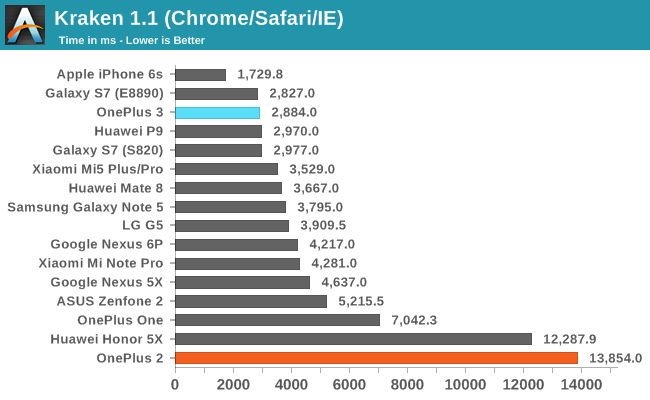
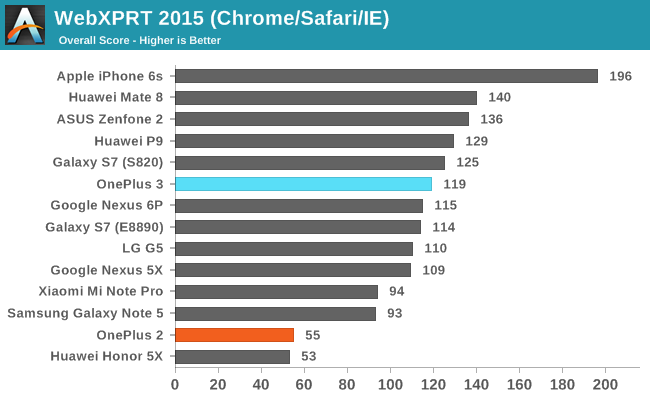
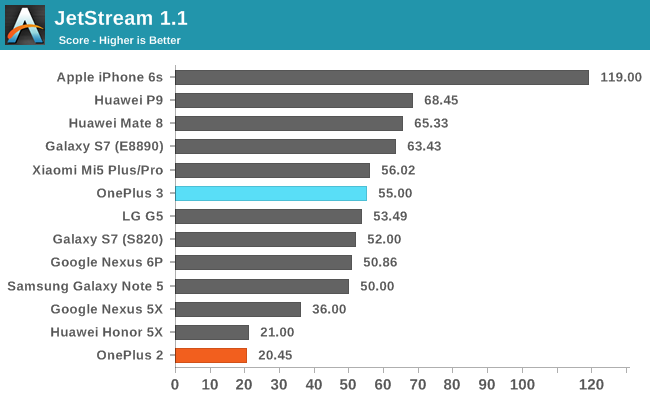
The improvement in web browsing performance when going from the OnePlus 2 to the OnePlus 3 is staggering. This isn't unexpected when you consider that the OnePlus 2 was just running on Cortex A53 cores that were meant for low power scenarios while the OnePlus 3 is using Qualcomm's Kryo cores. In Kraken the OnePlus 3 is over four times faster, while in WebXPRT and JetStream it's at least over two times faster. The OnePlus 2 actually represented a large regression in web performance compared to its predecessor, and OnePlus has brought web performance back to a level that is competitive with the other smartphones on the market with the OnePlus 3.

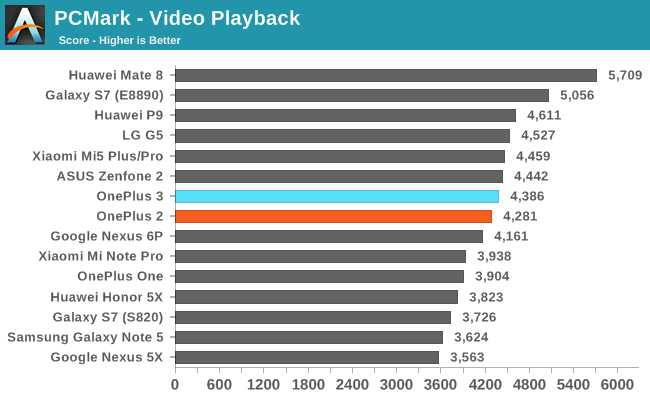

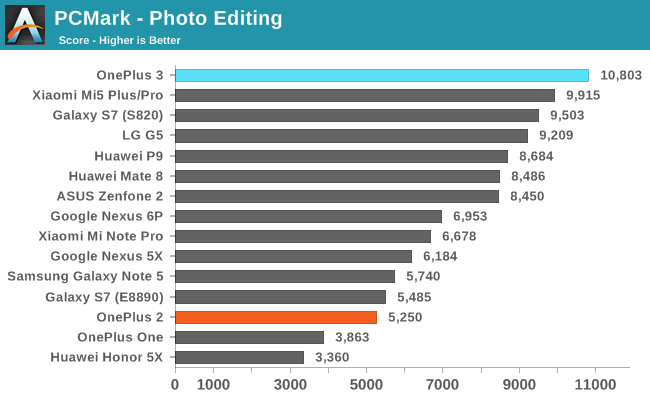
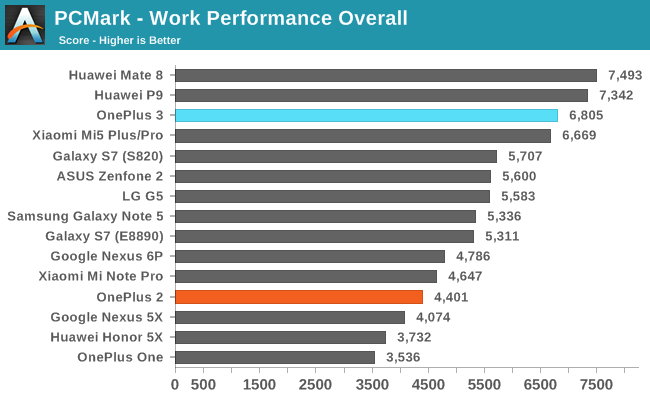
PCMark is an interesting test because it depends just as much on a phone's software as it does on the hardware. We've seen how devices with the same SoC can perform very differently, especially in certain sub-tests like the Writing and Photo Editing tests where different runtime and OS optimizations can have a large impact. The OnePlus 3 is no exception, with it achieving higher scores than the LG G5 in every test except for video playback where they have roughly the same scores.
This is not unexpected, as it was demonstrated in the LG G5 review that the G5 has more conservative frequency scaling than the other Snapdragon 820 devices that we've seen, which is reflected in PCMark's tests. In any case, the OnePlus 3 actually gets close to the Huawei Mate 8 in the writing test, and beats it and the LG G5 by a large margin in the photo editing test. In the end the OnePlus 3 places second on our overall chart, with only the Huawei Mate 8 ahead of it, and the gap between it and the Mate 8 being smaller than the gap between it and the Zenfone 2 which is the next fastest smartphone.
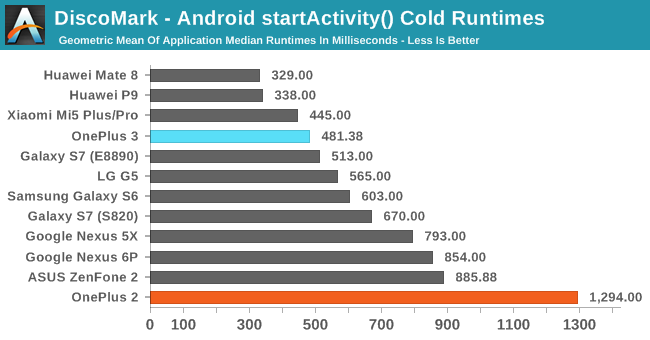
The OnePlus 3 is over two times faster than the OnePlus 2 with cold app launches where the application isn't resident in memory in any state. This is likely a combination of improved NAND performance, and changes to OnePlus's DVFS settings in addition to the performance improvements that Snapdragon 820 provides on its own. The impact that this has on the performance of the interface is significant, and when I reviewed the OnePlus 2 I noted how painfully slow it was to move around and through the applications. This new testing is a great example of that, with the OnePlus 2 taking 1.3 seconds just to launch apps, while the OnePlus 3 takes under 500ms and is the second fastest device here.
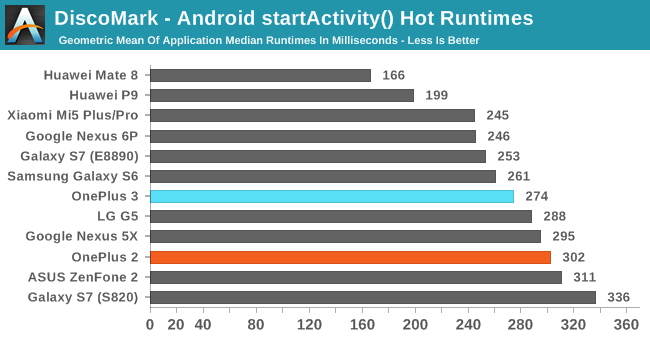
The OnePlus 3 improves a bit over the OnePlus 2 when resuming apps that are resident in memory, but not by a great deal. In general, all our devices hover between 250 and 300ms here, with the exception of the Huawei Mate 8 and P9 which are really in a category of their own for performance. While there's no enormous improvement here, the OnePlus 3 is competitive with other high end devices in the market, so there's nothing to complain about either.
One thing worth noting is that our set of apps wouldn't come close to utilizing the OnePlus 3's 6GB of RAM. Unfortunately, no matter how many apps we added, this would actually still be the case. The reason is that OnePlus has implemented very aggressive app eviction from memory, which means that your 6GB of RAM is really just sitting there using energy, and in general the utilization is pretty low. This may be a holdover from when the OnePlus 2 shipped in a 3GB configuration, but it's something OnePlus needs to address in a future OTA update. I'd imagine the Android enthusiast community is already at work on, or has already created custom kernels to alter this behavior as well. With 6GB of RAM you should be able to comfortably keep all of a user's frequently used apps resident in memory.
It's great to see that OnePlus is producing a smartphone with competitive performance once again. When the OnePlus One launched, Snapdragon 801 was the best you could get in an Android smartphone. The OnePlus 2 was an unfortunate victim of Snapdragon 810's heat and throttling problems, but OnePlus certainly didn't help the issue by hardcoding in mechanisms to detect Google Chrome and shut the A57 cluster off entirely. With the OnePlus 3 you get some of the best CPU performance in an Android phone, with PCMark's real-world tests demonstrating noticeable gains over the LG G5 which also uses Snapdragon 820. If I had to sum things up in a single line I'd just say that it's good to see that OnePlus is back in the game.


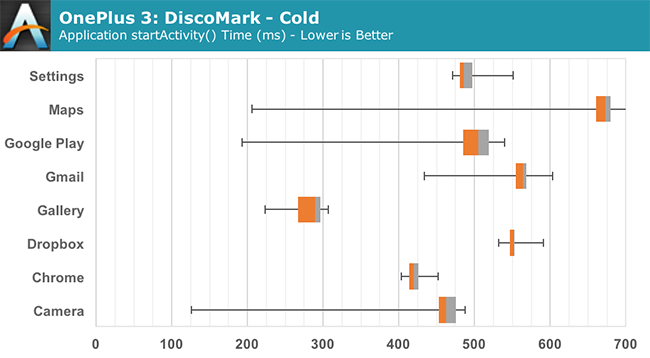
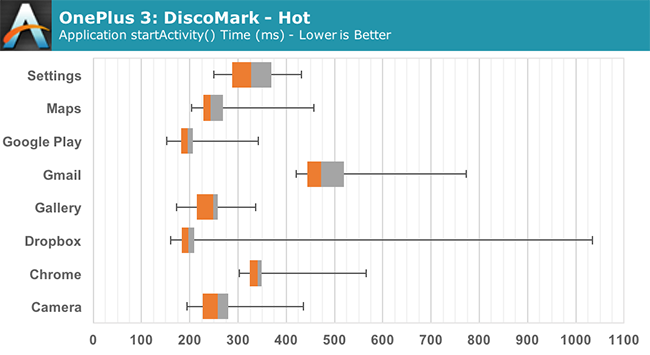








176 Comments
View All Comments
[-Stash-] - Tuesday, June 21, 2016 - link
I'm currently running a Note 3, which has a 5.7" 1080p pentile AMOLED screen. I *can* see the subpixels, but it also doesn't bother me. I'd much rather take the better GPU performance/battery life improvements (although we don't appear to be getting this latter one with the OnePlus 3). For the price, I think this is an excellent trade off.I'm all for getting even 4k and 8k screens into phones, but not until the GPU and battery trade offs aren't there. And to be honest, until we're pretty much back to a week long battery life, I say stick to the 1080p screen! I'd also be much more interested in seeing Android move up to 120fps for general usage, as it would reduce the screen latency a bit too and make things feel so much better.
The colour accuracy, or lack thereof, is a concern. The Dash Charger wouldn't bother me if there was still QuickCharge enabled (so you have choice) , but at this point, I think there's enough positives to give the phone a try and see if I can live with it. The price point is very keen and I can't afford to blow £500+ on a phone, so £309 for flagship performance and a decent (if not market leading) camera are enough for that price. Ideally I'd still also like microSD and a removable battery, but I think for this price, I'll settle ;)
Sivar - Tuesday, June 21, 2016 - link
4K or 8K on phones?Do you also profess that megapixel count is a good measure of camera quality, or that 96 KHz audio is better than 48KHz?
Pissedoffyouth - Monday, June 20, 2016 - link
I hope Andrei comes up with his SoC deep dives soon, been a while comingjospoortvliet - Monday, June 20, 2016 - link
Absolutely and a great review it is... awesome work!deskjob - Monday, June 20, 2016 - link
Excellent review! So basically, this is a HTC One M9 clone (aesthetics) with current flagship specs and a bad screen. I am somewhat sensitive to the green tint from pentile Amoleds (S6 was horribly green, S7 still a hint), so the screen on this alone is a dealbreaker. Good to know.Any news on the HTC 10 review?
JoshHo - Monday, June 20, 2016 - link
It will be arriving with the GS7 part 2 review.Roland00Address - Monday, June 20, 2016 - link
Thank You,But also remember If You Give a Mouse a Cookie ;-)
Meteor2 - Monday, June 20, 2016 - link
A (timely) phone review! A (timely) phone review!I nearly crapped myself when I logged on.
I'll go and read it now :-). Thank you very much!
zeeBomb - Monday, June 20, 2016 - link
Just want to mention:https://youtu.be/1fcIZctnRjE - fix for RAM issue
It saddens me 1+ did this to a device that boasts having 6GB of RAM. Before tweaking the max app count is 20. 20!? Shameful! Y'all remember the OPX having issues of performance cuz they LIED of having a 801 snapdragon AB version, but really it was an AA? smh.
If too lazeh;
1) root, get build prop editor
2) search for ro.sys.fw.bg_apps_limit=20 and change to a number no more than 60
3) enjoy, spread the word!
Vishalaestro - Monday, June 20, 2016 - link
why don't you put the old HTC one m7 to the low light test with these phones, i still think their support for low noise levels even at a much higher ISO is a feature that many companies can't offer now.